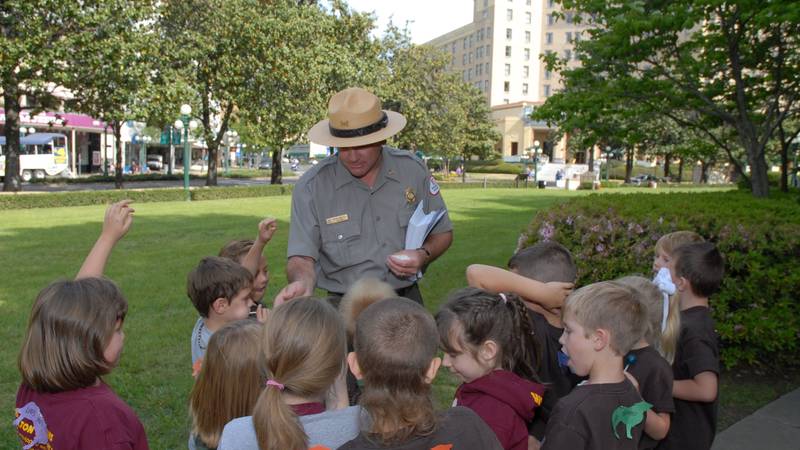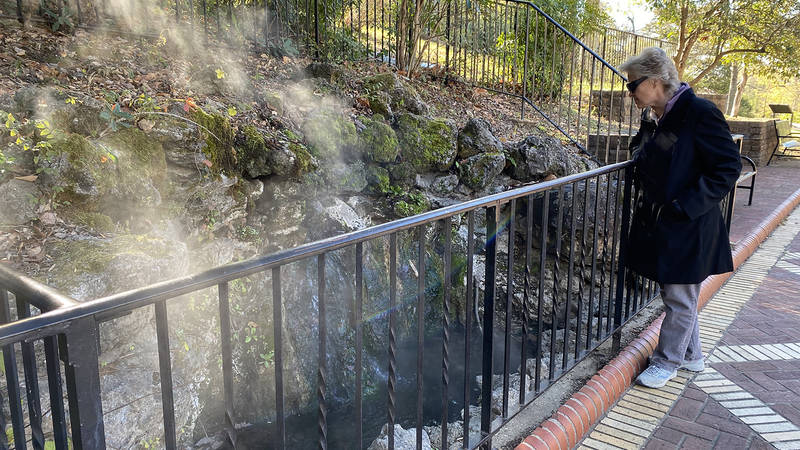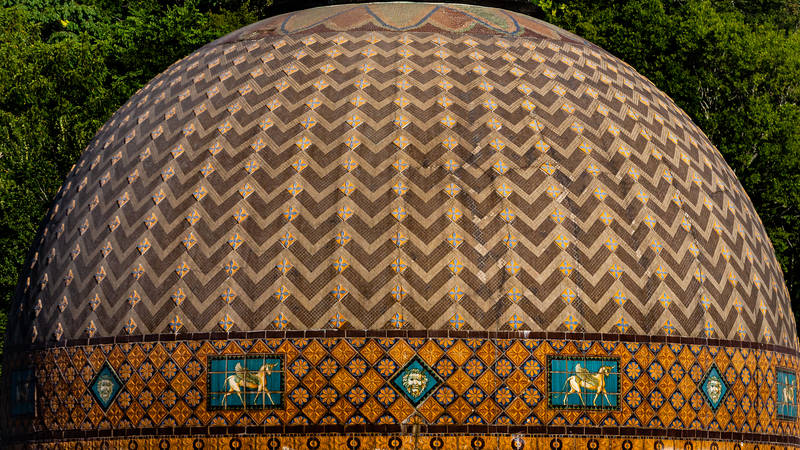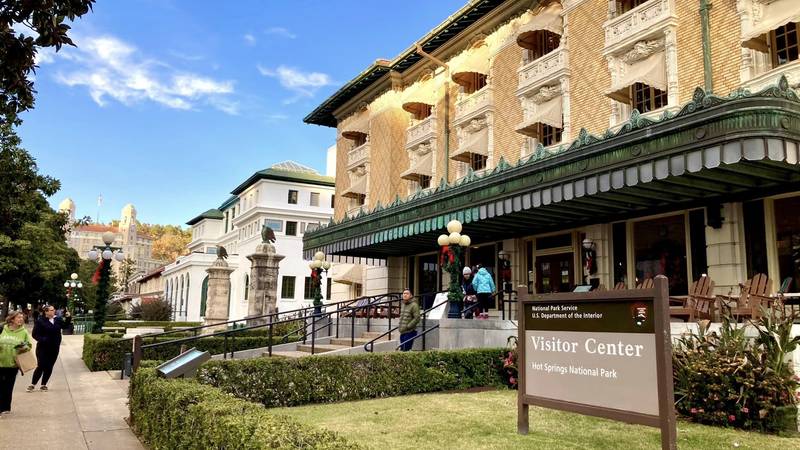One U.S. national park characteristically emphasizes health and well-being through its mineral waters — Hot Springs National Park in Arkansas.
In the early 1900s, Hot Springs National Park was the most visited health and wellness resort in the U.S, with entrepreneurs touting it as the place “where crutches are thrown away” because of its healing thermal waters.
Hot Springs is still a renewing place to spend a weekend — or longer! — indulging in spa services, watching the steam rise from exposed springs, hiking and biking the mountain trails, enjoying delectable meals and much more.
In 2021, 2.1 million people visited Hot Springs National Park, which is about an hour’s drive southwest of Little Rock, Arkansas. The park has no entrance fee.
Here are six “cool” facts about this hot-water park.
1. A blend of nature and city life
Hot Springs National Park combines urban and natural landscapes. Its 5,550 acres straddle a horseshoe-shaped ridge in the Ouachita Mountains. The park includes a vibrant downtown historical district called Hot Springs, which developed in the early 1800s because of people’s attraction to thermal waters. The city’s population is now 33,000.
The park’s downtown edge includes historic bathhouses, a brick-paved promenade and select open springs where you can touch the water. Downtown Hot Springs also hosts restaurants, bars, hotels, art galleries, novelty shops, attractions and a convention center.

A park ranger with children at Hot Springs National Park.
NPSWithin a short distance from downtown are access points to the national park’s 26 miles of hiking trails and Gulpha Gorge Campground, and to a privately owned 216-foot observation tower from which visitors can overlook 140 square miles of the park and surrounding countryside.
The town’s history includes some conflict: Civil War skirmishes, socio-economic and racial discrimination over who could access the thermal waters, gangsters and the killing of the nation’s first park ranger in the line of duty.
2. Water that is more than 4,000 years old
The water that surfaces in Hot Springs today originated as rain or snow about the time the Egyptian pyramids were built. It takes approximately 4,400 years for water to seep down through the rocks and fissures of the Ouachita Mountains to a depth of 8,000 feet, where it is heated by Earth’s core. The water then runs along a layer of impermeable rock until it hits a thrust fault that pushes it upward at the base of Hot Springs Mountain to the area of Bathhouse Row in downtown Hot Springs.

Steam rises from an open spring at Hot Springs National Park.
©Linda Coutant/NPCAOn its way upward, the heated water passes quickly through cooler ground water, which removes some of the heat before the water surfaces. The water temperature of the springs is still hot enough to eliminate harmful bacteria — an average 143 degrees Fahrenheit. The 47 springs produce 1 million gallons of water each day. Caps on the springs, as well as a central collection and distribution system, prevent contamination and keep the water safe for drinking and bathing.
3. The only national park with a brewery

The tap room at the Superior Bathhouse Brewery.
NPSSuperior Bathhouse Brewery, which opened in 2014, is the only brewery in a U.S. national park and the only brewery in the world using thermal spring water as its main ingredient. It is housed in the former Superior Bathhouse, which operated from 1916 to 1983 on Bathhouse Row in downtown Hot Springs — the longest continuous operation of all the Hot Spring bathhouses.
The steam-fired brewery makes 18 craft beers in house, plus root beer. During the building’s transformation from a bathhouse, the beer-making equipment — including 10 31-gallon barrels — had to be hauled through the building’s north side front windows.
4. A park that predates Yellowstone National Park
Yellowstone was established as the world’s first national park in 1872. But 40 years earlier, the U.S. government established Hot Springs as a federal reservation to protect the thermal waters for public use from the increasing number of settlers, businesses and health-seekers coming to the area. It was the first U.S. reservation created to protect a natural resource.
However, Congress failed to include a plan for administering the reservation — so, people continued to settle in the area and build businesses over and around the springs.

Significantly Steamy Parks
The National Park Service has designated the thermal features such as geysers and fumaroles at 16 national park sites as “significant,” a label that affords them more stringent protections. Only…
See more ›When the National Park Service was created in 1916, Hot Springs Reservation came under its jurisdiction. The Park Service’s first director, Stephen T. Mather, reportedly developed such a bond with Hot Springs after visiting for an inspection tour that on later stops he often skipped department meetings to take in a soak.
Mather’s devotion helped convince Congress to redesignate Hot Springs Reservation as a national park in March 1921. With the change, the government demolished aging buildings. It also began the final phase of construction and landscaping of Bathhouse Row and the half-mile-long Grand Promenade on the hill behind it, where spa patients were encouraged to stroll after their treatments.
5. The ornate architecture of Bathhouse Row
Bathhouse Row on Central Avenue consists of eight luxurious bathhouse buildings constructed between 1892 and 1923. These stone and brick structures replaced the fire-prone wooden and canvas structures early settlers built over open creeks and springs.

The domed roof of Quapaw Bathhouse in Hot Springs National Park.
NPS/Mitch SmithThe existing bathhouses represent diverse architectural styles: from Victorian to a mix of Classical, Mission and Spanish Colonial Revival. Features include tiled domes, stained glass and marble walls.
The hydrotherapy industry peaked in 1947, and most of the bathhouses closed by the 1970s. Two buildings remain active bathhouses, with modern spa features, while others have been converted to new commercial ventures.

Bathhouse Row at Hot Springs National Park.
Christina MayThe Fordyce, built in 1915, houses the National Park Service Visitor Center and Museum, which is adding new interpretive exhibits this winter.
The Park Service plans to rehabilitate the bathhouses this year through deferred maintenance and repair funding from the Great American Outdoors Act.
6. Public fountains where you can fill your own water jugs — for free
Since the waters in Hot Springs are federally protected for everyone, Hot Springs National Park is mandated to give away its primary resource in an unending and unaltered state.
The water was the first and remains the only federally controlled hot springs in the U.S. to be managed for both public health and personal consumption.
Seven thermal fountains and two cold spring fountains within the park allow the public to fill water jugs, bottles or cups for free. The park is reimbursed for managing the thermal water collection system by businesses that profit from the water.
Want to visit?
Learn more about Hot Springs National Park
Stay On Top of News
Our email newsletter shares the latest on parks.
About the author
-
 Linda Coutant Staff Writer
Linda Coutant Staff WriterAs staff writer on the Communications team, Linda Coutant manages the Park Advocate blog and coordinates the monthly Park Notes e-newsletter distributed to NPCA’s members and supporters.